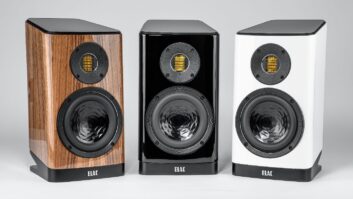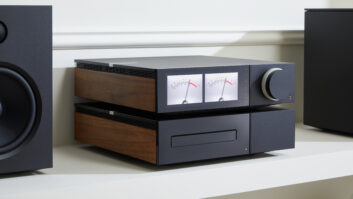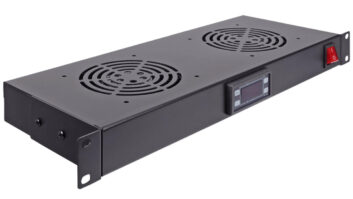AVR Technology Heads Further into the Cloud

Anthem’s MRX 700
Today’s AV receiver and processor manufacturers are jazzed up about mobile applications and increased network operability. The ultimate goal, of course, is to make consumers’ experiences as rich as ever while keeping the devices simple and user-friendly. Here are some of the latest products with insights on the technology in general and what product designers are focusing on.
Pioneer Electronics (USA) Inc. just introduced a new line of Elite-branded AV receivers designed to meet the needs of today’s connected consumers and their portable devices. The five new Elite models consist of the VSX-40, VSX- 50, VSX-51, VSX-52, and VSX-53. The VSX-50 is network capable with features like Pioneer’s iPhone and iPad apps, as well as iControlAV2, which controls the receiver, and Air Jam, which pairs up to four devices wirelessly to the receiver to create shared playlists. Apple’s AirPlay, DLNA, Bluetooth audio streaming, and IP radio also are included.

Onkyo’s TX-NR809
“Apple’s AirPlay technology has proven to be one of the most exciting new technologies for the AV receiver category. Our target demographic– home entertainment junkies–have home networks, and a large percent are also Apple enthusiasts,” said David Bales, manager AV marketing and product planning for the home entertainment division of Pioneer Electronics (USA) Inc. “We have had great success bringing Apple content to the home theater via wired connection, and now we are pushing iTunes wirelessly from the PC, iPhones, and iPads.”
On the video processing end, the 2011 Elite receivers use proprietary technologies to maximize the user’s television performance with video conversion and scaling, image enhancement, and video adjustment for detail, sharpness, brightness, contrast, chroma level, and black level for individual video sources. To enhance the video performance from any source connected, Elite receivers convert analog
On the video processing end, the 2011 Elite receivers use proprietary technologies to maximize the user’s television performance with video conversion and scaling, image enhancement, and video adjustment for detail, sharpness, brightness, contrast, chroma level, and black level for individual video sources. To enhance the video performance from any source connected, Elite receivers convert analog signals to HDMI and scale both analog and digital signals to 1080p resolution. Additional technologies include Marvell Qdeo processing, advanced video adjust and Stream Smoother to enhance the picture quality of any source.
“While home network content and control are exciting and new, the AV receiver still relies on things like build design and quality parts, advanced amplifier designs, step-up higher performance audio and video processing to provide the best experience,” Bales said. “All of these things cost money and are subject to economies of scale. It is critical that retailers find a way to effectively explain and demonstrate the value of the step-up and top-line products we manufacture to ensure that consumers have the opportunity to experience the best AV experience we can provide.”

Denon’s IN-Command series
Crestron’s Procise PSPHD high-definition surround sound processor features 7.3 HD surround sound processing. Audyssey MultEQ XT precision automatic room compensation to maximizes speaker system performance within acoustical space, and Audyssey Dynamic EQ assures consistent bass response, tonal balance, and soundstage at any volume while Audyssey Dynamic Volume solves the problem of spikes in volume level between television programs and commercials, and between the soft and loud passages of movies. HDMI connectivity provides transport for the 7.1 surround sound and 1080p HD video.
“HDMI has been one of the main reasons for creating the Procise PSPHD,” said Jeff Singer, Crestron director of marketing. “Up until recently, there weren’t any high-end surround processors that offered HDMI support; the only way to get full eight channels (7.1) of digital high-bitrate HD audio from a Blu-ray disc to your speakers.”

Crestron’s Procise PSPHD
Three floating-point DSPs and 24-bit 96kHz A-D/D-As enable the Procise PSPHD to achieve articulate sound with extreme dynamic range and low noise down to 125 dB SNR. Pure mode bypasses all signal processing to provide a pure signal path for critical listening. Support for HDCP ensures the most reliable handling of digital HD content and compatibility with the widest range of devices. The PSPHD connects with up to 30 inputs including HDMI, AES/ EBU, S/PDIF optical, and coaxial, in addition to mono, stereo, and multichannel analog.
“Aside from the inherent challenges that lie within switching and routing HDMI signals, surround sound AV processors have the challenge of ���keeping up with the times,’” Singer said. “There are myriad surround sound formats and bit-rates which have evolved over time. These will continue to advance, requiring processors to stay up-to-date. Designing a processor not just for today, but for tomorrow, is a tall order. The advantage that Crestron has is our ability to update firmware and add support as these shifts take place.Theta Digital’s updated Casablanca III HD preamp processor adds four HDMI 1.4 inputs and decoding for Dolby TrueHD and DTS-HD Master Audio. Two new programs allow older-generation Casablanca owners to keep their components updated. One adds three new circuit boards, a power supply, and a new operating system to the existing Casablanca III. The other program is for Casablanca I or II trade-in allowance of up to $5,000 applied to the purchase of this latest HD-updated, third-generation Casablanca.

NAD’s T 757
Anthem’s MRX 700 receiver, introduced in December 2010, features seven amplification channels, four HDMI in/one out, and the ability to play music from a flash drive, USB disk drive, or the internet. For optimal sound reproduction from any set-up, the MRX receiver is also equipped with the Anthem Room Correction (ARC) system. The receiver supports the latest audio formats, including Dolby TrueHD, Dolby Pro Logic IIz, and DTS-HD Master Audio. Both internet and HD radio are available.
MRX series receivers will also provide pass through for 3D movies and TV when paired with a 3DTV and a 3D capable source component. Other features include trigger output and second zone functionality, as well as video configuration memorized by source.

Marantz’s SR6006
Denon’s IN-Command series includes Apple’s AirPlay, direct connectivity for integration to the home network via USB. Denon’s Party Mode Plus feature allows simultaneous music playback in up to five rooms, when connected to compatible Denon products.
“One of the hottest trends is content access and network streaming,” said Jeff Talmedge, product development and systems integration director for Denon. “People want to easily access all their music and video and stream it to their entertainment networks–both from inside and outside the home. It’s all about the digitally connected ‘networked home,’ and that is why Denon has developed leading-edge content access and streaming capabilities for our receivers.”
Talmedge said AirPlay “is certainly one of our most exciting features, and we are thrilled to be among the select companies that are offering this aheadof- the-curve capability to our customers.”
The IN-Command series models include Dolby Pro Logic IIz decoding. The three models in the series all feature dual differential 24-bit/192-kHz DACs per audio channel, and Audyssey Dynamic Volume, Audyssey Dynamic EQ, and Audyssey MultEQ XT.
Talmedge predicted that cloud trend will continue to take off in AVRs. “The future will most likely see a proliferation of advanced content aggregation technologies, with access to cloud-based services such as those from Amazon and Google, as well as Apple’s new iCloud–all of which will open up tremendous new opportunities for enjoying expanded entertainment virtual libraries.”

Theta Digital’s Casablanca III
The T 757 AV surround sound receiver from NAD features MDC, which is NAD’s answer to technology that becomes outdated too quickly by upgrading the receiver to include future digital formats.
“The conversion to digital video and HDMI has required a lot of investment and really led to NAD’s greatest innovation: modular design construction,” said Greg Stidsen, director of technology and product planning for NAD parent company, Lenbrook International. “The endless revisions of HDMI have kept customers guessing about whether to purchase a new AVR or wait. With MDC they don’t have to wait, because they can simply upgrade their digital audio and video hardware and software to keep pace with new digital formats and features.”
The latest high-speed DSP decodes popular surround sound formats, including Dolby TrueHD and DTS Master Audio. Stereo source material can be converted to surround sound with NAD’s EARS surround mode. Analog video sources are supported on HDMI for one wire connection to flat screen or projector displays.
The user interface retains custom settings, and there are no empty inputs, which can be confusing for users. Presets enable custom setups for different program material, and inputs can be renamed to match specific components. The internal amplifier powers a second, independent zone.
Many of these features have been designed with simplicity as a top priority, Stidsen added. “I think we have reached a point of saturation, of ‘feature fatigue.’ We see the pendulum swinging back toward simplicity,” he said. “Customers want great performance and they want easy. The technology should be invisible.”
On the music end, an iPod dock can be added to the system and displayed on screen. The T 757 also features an FM/AM tuner, 30 station presets, and RDS support. There is also an optional DB 2 digital DAB+ module for high quality digital radio.
Stidsen believes one of the challenges that the technology faces in the future is “keeping pace with new ways of consuming content.” The “video cloud,” as he calls it, “is a consumer-driven feature, and we’ll see many more sources for this content popping up. Our job is to connect with that content and make it sound and look as good as it possibly can.”
Marantz America has introduced two seven-channel networking audio video receivers: the 110 watt-per-channel SR6006 and the 100 watt-perchannel SR5006. Built-in AirPlay compatibility in both receivers allows users to stream their iTunes music, as well as music stored on their iPad, iPhone, or iPod touch to select components connected through an existing Wi-Fi system.
James Ludoviconi, brand and product manager for Marantz identifies networking and streaming audio technology as the AVR wave of the future. “Our new AVRs and network audio player with AirPlay are bridging the gap between the private nature of the iPod and the shared experience of listening to music through a home audio system.”
Both models were designed with the Marantz star and porthole display, along with features like built-in HD radio tuners, multiple HDMI 1.4a inputs, and Bluetooth capability.

Pioneer Electronics’ Elite receiver
These receivers are designed to build expanded home entertainment networks. The HDMI 1.4a 3D/audio return channel repeating capability allows users to connect two separate displays and switch from one to the other without changing cables. In addition, both provide upscaling of the HDMI signal to HDMI 1080 video signal. Both also feature front-panel USB inputs that are compatible with the iPod and iPhone, and support playback of MP3, WMA, and WAV files, as well as provide playback control via remote while showing music track information on the unit’s newly designed interface.
The SR6006 allows for streaming of Pandora, Rhapsody, Napster, and Flickr, as well as audio and photos directly from PCs. Users have access to more than 14,000 internet radio stations and a variety of providers, such as Rhapsody and Napster.
Ludoviconi said the AVR technology is going to the cloud, “without a doubt, noting that the cloud “is changing the way folks manage their digital content, including music. “Apple’s approach, with their huge installed base of iTunes users, is going to have a profound effect,” he explained. “Suddenly it’s all about the device; the tether to the PC has been severed forever. The onus is on the audio manufacturer to interface directly with the device.”
McIntosh Laboratory’s MX150 AV control center features an up-converting video processing engine with advanced HDMI 1.3 capability, as well as DolbyHD and DTSMaster decoding, onboard RoomPerfect auto-equalization, multiple subwoofer capability, and software management via USB, Ethernet, and Compact Flash.
The MX150 features five HDMI 1.3 AV inputs and is engineered to function with the latest audio processing technologies for seamless compatibility and performance with Blu-ray players. The unit’s five component, two S-video and two composite video inputs help ensure expandability, with user preferences assignable per source.

McIntosh’s MX150
“McIntosh’s MX150 offers advanced features like audio room correction and source programming modes, both technologies that have made great advancements in the past few years,” said Ron Cornelius, McIntosh product manager.
Video signals are minimally processed to preserve their integrity and maximize hardware compatibility. Analog video is transcoded to digital HDMI with the original scan type, line resolution, and frame rate preserved. HDMI video is passed through unaltered.
For added flexibility in multi-zone system building, the MX150 is a two-zone controller with both zones controllable from the front panel or with remote sensors/keypads and comes complete with an event based learning remote control.
From a product design perspective, Cornelius said that the most significant challenges in designing home theater processors is to first build in the flexibility and custom features needed by the system designer and installer. Second is to make sure that the finished installation is easy to use and exactly matches the needs and intended use of the consumer. “This integration of technology and user interface rests on both the product and the talent, training and commitment of those installing it,” he concluded.
Lindsey Snyder ([email protected]) is assistant editor to Residential Systems and Systems Contractor News in New York City.







